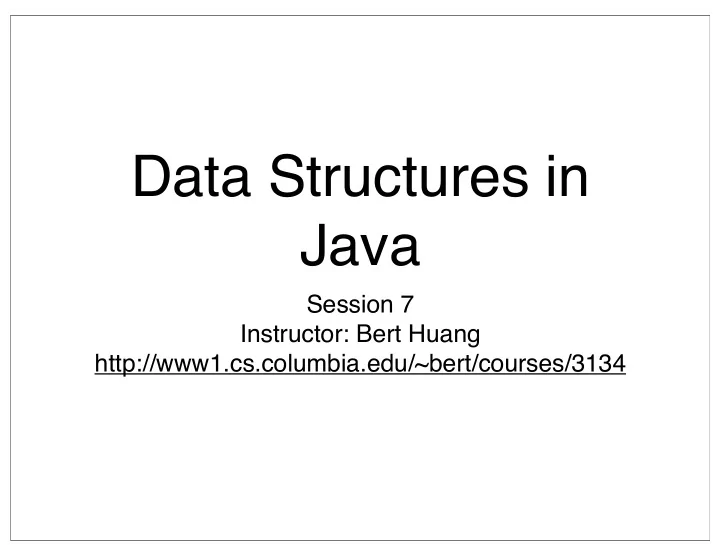

Data Structures in Java Session 7 Instructor: Bert Huang http://www1.cs.columbia.edu/~bert/courses/3134
Announcements • Homework 2 released on website • Due Oct. 6 th at 5:40 PM (7 days) • Homework 1 solutions posted • Post homework to Shared Files, Homework #2
Review • Review of scope • Stack applications examples • Stack implementation (easy) • Queue ADT definition and implementation
Today ʼ s Plan • Lists, Stacks, Queues in Linux • Introduction to Trees • Definitions • Tree Traversal Algorithms • Binary Trees
Lists, Stacks, Queues in Linux • Linux: • processes stored in Linked List • FIFO scheduler schedules jobs using queue • function calls push memory onto stack
Drawbacks of Lists • So far, the ADT ʼ s we ʼ ve examined have been linear • O(N) for simple operations • Can we do better? • Recall binary search: log N for find :-) • But list must be sorted. N log N to sort :-(
Trees • Extension of Linked List structure: • Each node connects to multiple nodes • Example usages include file systems, Java class hierarchies • Fast searchable collections
Tree Terminology • Just like Linked Lists, Trees are collections of nodes • Conceptualize trees upside down (like family trees) • the top node is the root • nodes are connected by edges • edges define parent and child nodes • nodes with no children are called leaves
More Tree Terminology • Nodes that share the same parent are siblings • A path is a sequence of nodes such that the next node in the sequence is a child of the previous
More Tree Terminology • a node ʼ s depth is the length of the path from root • the height of a tree is the maximum depth • if a path exists between two nodes, one is an ancestor and the other is a descendant
Tree Implementation • Many possible implementations • One approach: each node stores a list of children • public class TreeNode<T> { T Data; Collection<TreeNode<T>> myChildren; }
Tree Traversals • Suppose we want to print all nodes in a tree • What order should we visit the nodes? • Preorder - read the parent before its children • Postorder - read the parent after its children
Preorder vs. Postorder • • // parent before children // parent after children preorder(node x) postorder(node x) print(x) for child : myChildren for child : myChildren postorder(child) preorder(child) print(x)
Binary Trees • Nodes can only have two children: • left child and right child • Simplifies implementation and logic • public class BinaryNode<T> { T element; BinaryNode<T> left; BinaryNode<T> right; } • Provides new inorder traversal
Inorder Traversal • Read left child, then parent, then right child • Essentially scans whole tree from left to right • inorder(node x) inorder(x.left) print(x) inorder(x.right)
Binary Tree Properties • A binary tree is full if each node has 2 or 0 children • A binary tree is perfect if it is full and each leaf is at the same depth • That depth is O(log N)
Expression Trees • Expression Trees are yet another way to store mathematical expressions / * 300 • ((x + y) * z)/300 + z • Note that the main mathematical x y operators have 2 operands each • Inorder traversal reads back infix notation • Postorder traversal reads postfix notation
Decision Trees • It is often useful to design decision trees • Left/right child represents yes/no answers to questions Hungry? Do nothing Enough money? Chicken and Rice Subsconscious
Reading • This class: Weiss 4.1-4.2 • Next class: Weiss 4.3
Recommend
More recommend